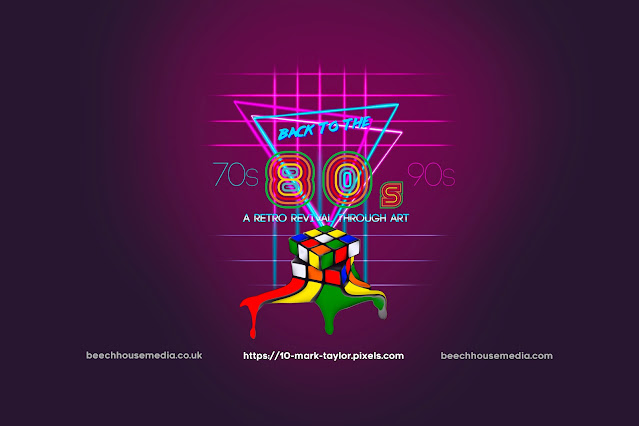
 |
| Can Art Save the High Street? |
Remember those bustling
Saturdays on the high street, the shared joy of finding a bargain, or the
anticipation of trying on a new outfit? Those bygone moments seem increasingly
distant, replaced by boarded-up shops and the convenience of online clicks. But
is the decline of the high street inevitable and can art and creativity really save
it?
This time I explore a
different path for high streets around the world – one where art becomes the
vibrant paintbrush, reimagining the high street as a canvas for community,
experience, and possibility.
This post marks a milestone –
my 400th blog! With artificial intelligence (AI) on the rise and people busier
than ever, I wondered about the future of blogs and the direction I should take
with this site. Some might see blogs as outdated, but AI can’t replicate humanity
without it appearing fake or stereotyped – nor can it convey the
“why” behind my art.
Blogs remain a powerful way to
connect with a real audience and a way for artists to provide the narrative to
their work and the thinking behind it. That’s something that is difficult to
convey through a regular artist website, most are geared towards driving
traffic to purchase routes and I think art, and artists deserve more than that,
but maybe I’m just old school.
So, I’m embracing my humanity
and focusing on what AI can’t do. I’ll be diving deeper into my retro-inspired
work, providing a narrative alongside the art that documents the what, when,
and why, rather than the previous 399 posts that have really focussed on sharing
knowledge and experience.
The art world constantly changes
but it also stays the same, once you gain experience it becomes easier to
navigate and by easy, I mean well, it will still be character building but
experience will give you the skills to get you through. I’ll still share
knowledge but it won’t be the sole focus of this site, there are 399 posts that
say what needs to be said that I’ve written already!
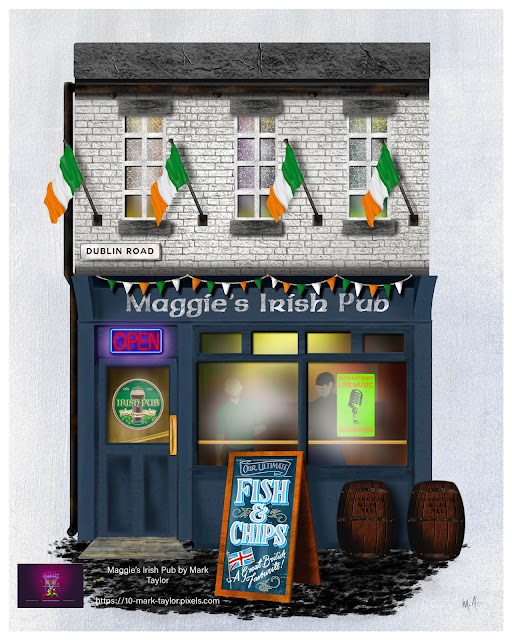 |
| Maggie’s Irish Pub by Mark Taylor |
Over the years, I’ve created
hundreds of pieces depicting life in the 70s, 80s, and 90s. While I’ve built a
collector base with landscapes and abstracts I haven’t shared much about these
“retro” works, which were often commissioned. I’ve painted icons and
memories from the 80s since the 1980s, everything from early digital pre-Warhol
period work right the way through to cover art.
From now on, expect a deeper
dive into my process behind the art. Ultimately, I want to create a visual
record of these three influential decades, a time of not just technological
revolution, but also a period in time that witnessed a major shift in people’s
attitudes towards everything from art to consumerism, even politics. I’m also
getting to that particular point in my art career that making a stand or making
a point with my work is an itch I need to scratch.
This post introduces my latest
series, exploring the changing face of the high street. Throughout this series I
juxtapose thriving businesses with those that have closed, reflecting the
decline of these once-sacred spaces.
It’s a reminder of what we’ve
lost and a look at the complex factors at play. The future of brick-and-mortar
stores is uncertain, with online giants like Amazon changing how we shop. We
might even question if the high street’s heyday was already fading in the 80s!
This series is a starting
point for a conversation – what will become of the high street?
The British high street, once
a bustling centre of life and commerce, now stands at a crossroads. This story
echoes across the globe: what were once proud symbols of community and commerce
are now boarded up, or filled with replacements that don’t quite capture the
same spirit.
In the UK especially, these
replacements can be puzzling. Small towns with ageing populations might have
seven Turkish barber shops, charity shops (thrift stores in the US), American
candy stores, and nail salons. Who needs that many barbers when there’s less
hair than customers?
Of course, this decline isn’t
universal. Thriving high streets still exist in some parts of Europe and the
US. But wherever decay sets in, for social, economic, or political reasons, a
shadow falls over the community.
Here in the UK, the
independent art supply store I relied on is gone. Now, a quick canvas for a
commission requires online ordering or a long drive. This has a ripple effect –
the high street used to be vital for local businesses to connect with each other.
Now, it’s a waiting game of unreliable deliveries, a system that doesn’t care
if your art supplies arrive broken.
Look, I know I might sound
like someone yelling at clouds, but I truly wish we could find something that
brings communities together again.
The exact start of the high
streets decline is hard to pinpoint. Some high streets thrived longer than
others. But for Britain, I suspect the 1980s marked a turning point. The decay
crept in slowly, cracks appeared that we just didn’t see at the time.
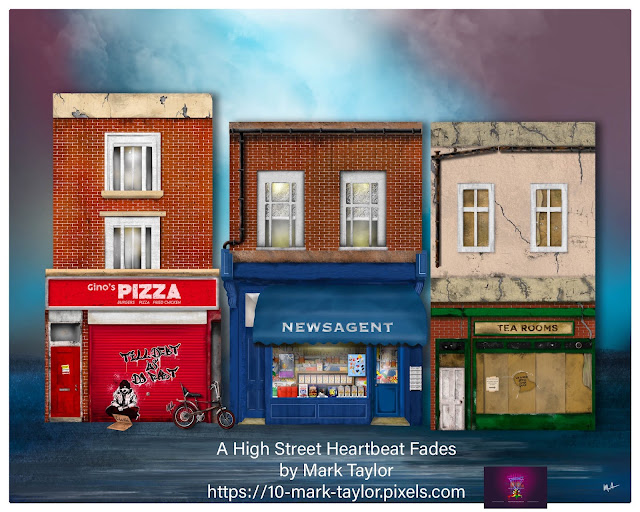 |
| A High Street Heartbeat Fades by Mark Taylor |
Out of town shopping centres,
although popular in the early to mid-1970s, began to sprawl into new urban
areas. In the United Kingdom, new towns had been created to manage the
population overspill from surrounding areas, old minefields were converted into
housing estates, development corporations sprang up, and Milton Keynes, a new
town way north of London had concrete cows installed in a field and everyone
thought it was fun.
Despite being newly created
with new people everywhere there was still a sense of old-small town community
present, but this spirit hinged on having lots of new town benefits such as
vibrant high streets, enough local facilities and police that policed, doctors
that doctored, and schools that didn’t have to compete for students through a
league table and that weren’t falling down because they used the wrong type of
concrete. I kid you not, that’s what’s happening with schools here in Blighty.
New homes were built at pace,
something that rarely happens in the modern day. High streets flourished from
new footfall and they really did become hubs for the community to gather. Out
of town shopping centres and malls were rapidly created, they offered a
convenience and had everything in one place and they had exciting and exotic
brands that could never be found in regular stores.
Malls, at least initially were
never seen as an immediate threat to the high street. They were still bricks
and mortar, and it was unlikely that small independent retailers would want to
go head to toe with the big players and they often sold very different things.
There was space for both.
The supermarkets and grocery
stores were some of the first to transition completely to the out of town malls,
they could carry much more stock and provide even more choice for customers in
the bigger locations. I remember a couple of supermarkets moving out of town,
but there were still smaller retailers who could fill the void, not everyone
wanted to visit the mall and not everyone could travel easily but when the
supermarkets began to leave the high street it would be another chip in the
fabric.
These out of town centres were
convenient but there was a reliance on either using public transport or
travelling by car, the traditional local high street still served a purpose
especially as car ownership in the UK during the 70s was still relatively low. So
why do I say the 1980s had been pivotal in the decline of high streets at a
time when high streets were still vibrant and booming?
Whenever I ask anyone this
question they undoubtedly say that the internet doomed the high street, I’m not
sure that’s entirely the case because we didn’t have the internet back in the
80s, although there’s little doubt that the internet would certainly accelerate
and seal the fate of the high streets
decline in the future.
I think it all started with a
combination of things. A perfect storm of innovation and technology coming
together and the visionaries who embraced those early technologies and began to
wonder how life changing it could be in the next decade and beyond. Little did
they know just how much of a leap they were about to make.
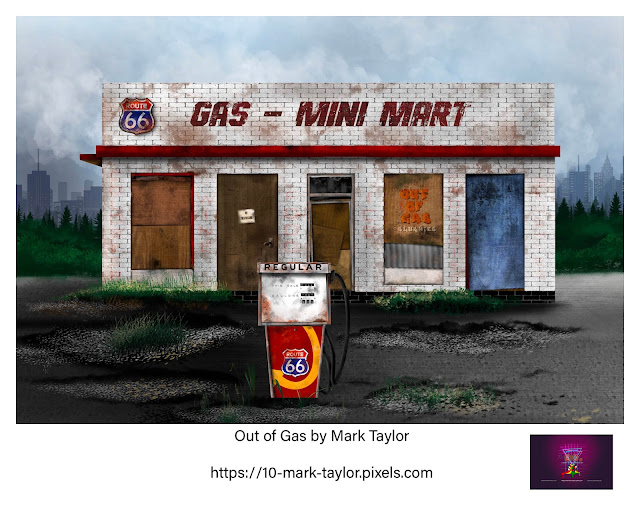 |
| Out of Gas by Mark Taylor |
Pre-web based systems were
undoubtedly another gateway to the future decline of the high street. They made
little to no real impact on local retail footfall at the time, but the seeds
had been sown, maybe even inadvertently, I’m not sure anyone in the 1980s would
have believed that the future high street would be accessed through a keyboard.
Those pre-web technologies
such as bulletin boards (BBS) which sprang up in the early 1980s, using platforms
like the Boston Computer Exchange (1982) facilitated online classifieds and rudimentary
electronic shopping. They mainly focussed on used computers and
tech-related products, which were still very specialist and very niche on the
high street. Transactions often involved phone calls or mail orders for
payment and delivery.
France’s Minitel (1982) and
the UK’s Prestel (1979) were videotex systems accessed through TVs and
dedicated terminals. They offered online
banking, classifieds, and limited online shopping through text-based
interfaces and proprietary protocols.
Both of these technologies
were niche, but the target audience for these systems were more likely to eventually
become the tech entrepreneurs that would take the seeds and push the technology
even further by creating emerging web based systems. Mainly in the guise of CompuServe
Electronic Mall (1985) and Freenet (1986).
CompuServe was one of the
first online shopping malls accessed through dial-up connections, offering
product information and ordering from various vendors. Payment often
involved pre-paid accounts or credit card orders over the phone. Encryption,
forget it, it wasn’t unusual to cut out an order form from a magazine and send
all of your credit card details through the traditional postal services.
Freenet was an early
peer-to-peer network allowing users to share files and
information, including software and digital art. Though not
technically e-commerce, it laid the groundwork for decentralized online
distribution models. This would become pivotal in the years ahead and
solidified the foundations for the internet we know today.
There were other developments
too, Electronic Data Interchange (EDI) was being used in the 1980s to
exchange purchase orders and invoices electronically and it is this that would
form the foundations for B2B e-commerce in later years.
By this time, online banking
began to emerge and this allowed customers who had invested in these early
technologies to do some very simple online tasks such as checking balances and
in some instances they were even able to make rudimentary transfers, something
that would later mature into the behemoths of banking systems that we see
today.
There were still plenty of
limitations and challenges that would stall the inevitable changes that were to
come, dial-up internet was slow, internet connections were much less prevalent
than they are today, and there were concerns around limited security especially
when it came to data security and online payment fraud, problems that would
exponentially grow over time as both the systems and the scammers matured into
more complex beasts.
These were barriers for
consumers and whilst those consumers were buying into the shiny new home
computer and PC thing which was being heavily advertised, the public were less
willing to engage with the online world because there was a cost barrier and to
be honest, people were generally either playing video games or using
productivity software. This was the golden age of Lotus 1-2-3, folks.
The majority of the mainstream
consumer population had little to no idea of the online world and when they did
catch a glimpse of it, that world was usually presented through clunky text
based interfaces or depicted on glass screens in a control centre as the
central focus of an action film. Remember, this was still very much rooted in
the days of early IBM, DOS, and very much pre-Microsoft Windows. There were no
user friendly interfaces, the interaction was often limited to typing on a
keyboard.
Overall, online commerce in
the 1980s was nascent and far from mainstream. But these early experiments and
technological advancements laid the groundwork for the explosion of e-commerce
that would happen in the following decades and I think that was the point that
the high streets fate was finally signed, sealed, but still as yet to be
delivered.
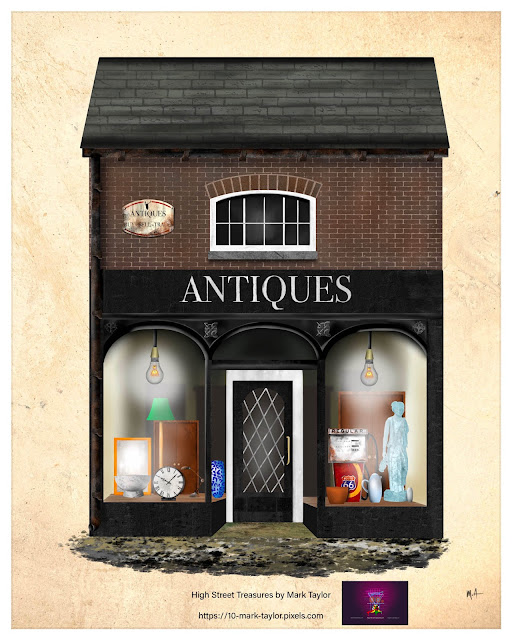 |
| High Street Treasures – Mark Taylor |
Television advertising in the
80s was on another level. In the decades since a lot has changed in the world
of TV advertising, its format, how ads would be targeted, the consumer
experience and there are huge differences not only between 80s and modern day
production quality standards but also in the content that ads were able to display.
Advertising cigarettes was a
huge source of ad-revenue in the 80s, I still remember the Marlboro ads, and in
the UK, the John Player Special ads that were adorned on formula one racing
cars. Tobacco advertising was banned in the UK and other territories over the
following years and TV advertising shifted away from the typical stereotypes
that had been used in the earlier years, but it still had a way to go to get
where we are today.
In the 1980s, ads would
typically run between 30 and 60 seconds, usually aired between scheduled
programming blocks and limited in number per hour. A 30-minute program might
have had ads at the start, halfway through and again pre-the next program, hour
long programs would generally see advertising every 15-minutes here in the UK,
in some countries ads were even more prominent.
There were limited channels
and viewers had nowhere to hide. It wasn’t until the mid to late 80s that video
recorders became much more mainstream and allowed consumers to record TV and
fast forward through the ads. In short, advertisers and ad-executives had a
captive audience, but as an advertiser you had little to no idea who those
people were.
The ad-men/women of the 80s
certainly had their challenges with this lack of trackability, but ads worked
perhaps because they were largely unregulated in the same way as they are
today. Content was genuinely, if not politically correctly, sticky. It
resonated because the messages were far less subtle than they often are today
and consumers were still largely discovering technology for the first time.
Catchy jingles, celebrity
endorsements, no influencers or con-fluencers as I like to call the majority of
them (oh my I do sound old and grumpy), and while I can say that I didn’t
always agree with the portrayed stereotypes, advertisers were bold enough to
push humour in ways that make todays ads sterile enough to avoid any possible
litigation. TV is rarely brave in the modern day.
Maybe because we also had
regional programming and entertaining TV that would be watched by millions of
people in real time, I think I would be minded to say that those ads probably
worked better than the hyper-targeted, highly focus group led ads that we see
today, albeit some of those 80s ads would be best left in the 80s or completely
forgotten.
Economic Restructuring…
The 1980s also witnessed
economic restructuring, leading to the decline of some traditional industries
and increased competition from overseas goods. This impacted local economies
and potentially reduced spending on non-essential items typically found on the
high street. Unemployment was significantly higher than it had been and there had
by then been a decline, particularly in rural England within industries that
had for hundreds of years been the providers of a stable income for generations
of the same families.
Coal mines had been shut down,
the steel industry was in decline, it was a decade of either decadence and
success or complete despair depending on what industry you worked in. An
inequality that had existed before was being amplified across communities and
this would eventually trickle into high streets up and down the country. Politics
played a hand too, but that’s a complicated story for another time.
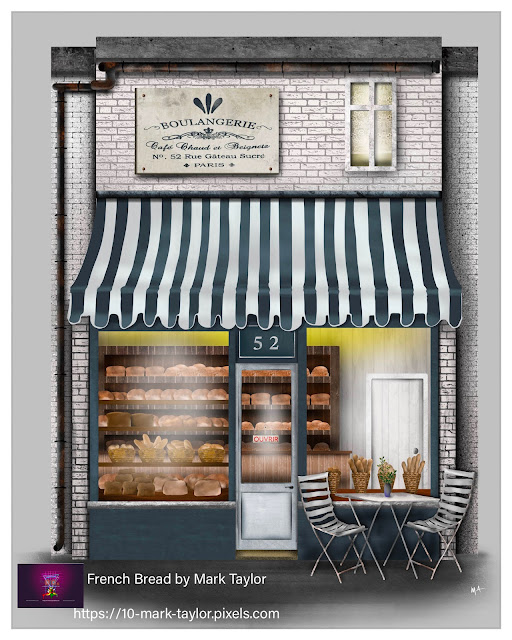 |
| French Bread by Mark Taylor |
Beyond purely technological
factors, the 1980s witnessed a shift in consumer preferences towards
convenience, brand recognition, and value for money, which out-of-town shopping
centres and early online retailers aimed to capitalise on. Advertising was
becoming more powerful and the world was becoming exponentially smaller with
the advent of mobile phones, early websites and a growing awareness about how
the online world would provide the future of flying cars that we had been
promised in the 1950s and 60s.
People were ready to embrace
change and by the mid-80s, were also being encouraged to buy into the world of increasingly
more affordable technology. Home computing saw its barriers to entry removed
with the introduction of cheap 8-bit home microcomputers, and the rapid pace of
technical innovation began to get people excited for the future.
I often wonder how many of
those people, me included, figured that technology would eventually have such
an impact on everyone’s lives. The target audience at the time were mostly
living in the here and now, and many of them were wearing Swatch watches and
gaudy colours from United Colors of Benneton. Looking back, the 80s were very
much all about living in the now.
It’s important to note that all
of these these factors intertwined, The convenience of out-of-town centres was
partly enabled by improved transportation infrastructure, itself a product of
technological advancement. The rise of TV advertising and direct marketing
relied on technological developments in communication and changing consumer
preferences were likely influenced by factors like economic restructuring and
the overall cultural shift towards mass consumption led by the brands and the
marketing teams.
The 80s was the real
birthplace for mass consumerism, even I bought into it when I got my first
Filofax which I carried around but didn’t have either the responsibility or the
social life to fill in. One year later, that Filofax still had no entries, but
it was a free gift with a bottle of Drakkar Noir, an 80s aftershave that I
still wear to this day.
As I said earlier, it was a
combination of things that scuppered our Saturday afternoons bumbling around
the local shops. It was a perfect storm and a hive mind of innovation that
finally sealed the high streets eventual fate, but there is little doubt, that while
the fast pace of technological change in the 1980s wasn’t the sole culprit, it
was undeniably a contributing factor in its decline.
Beyond the economic impact,
the decline of the high street has woven itself into the fabric of social loss.
Independent shops and businesses, still to a large extent where they still
exist are the lifeblood of many communities but where they have been forced to
close, the closures also shuttered access to the personalised services and
unique products, and tactile buying experiences that they offered. Much of the
high street of the past was broadly, all about the experience and in part, the
human connections that could be made.
Retail was a by-product of
social interactions, as the decade matured consumerism began to reach fever
pitch. You could literally rock up on a street corner and sell toilet tissue
from a suitcase and people would buy into it and then it all crashed in 87.
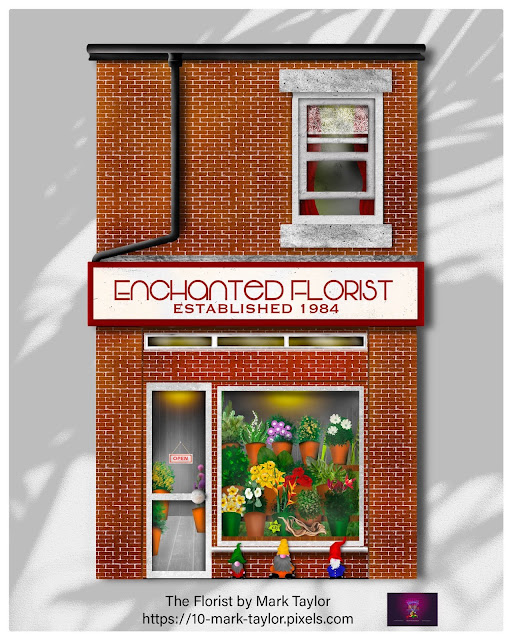 |
| The Florist by Mark Taylor |
It’s not
all bad news for high streets, many communities are fighting back, championing
local businesses, hosting vibrant markets and many are really pushing the arts
and crafts movement. It’s not unusual to see communities working with local
authorities and landlords to transform vacant spaces into community hubs.
Innovative retailers are blending online and offline experiences, offering
click-and-collect services and personalised in-store consultations, so what
about the future?
For those
of us who might be looking at the past through rose tinted glasses and holding
out for a return of the high street as it was, I think we have to face the
inevitable that we are unlikely to ever see that type of high street ever
again. That’s probably not such a bad thing, the high street has had a history
of change for hundreds of years.
There’s
also a question as to whether High Streets are worth saving, I believe they
are, they remain critical to local economies and provide employment
opportunities without which economies would stagnate and decline even further.
How we go
about saving them is a bigger question, especially during times when finances
are stretched and you need more money to buy less. High streets have become much more complex in
how they’re made up too. Multiple landlords, much more stringent regulation,
less footfall, in some cases perhaps because they’re also much less accessible
than before, and sprawling urban areas mean that high streets are further away
from where people live.
The high street’s decline is a
complicated issue with no easy answers, but there are pockets of hope from
centres that have been entirely reimagined, and where communities and planners
have been thinking outside of the proverbial box.
The narrative of decline is
different the world over. In Europe, many high streets have continued to
thrive, albeit in a reimagined way and mostly due to the strong social safety
nets and cultural significance of public spaces which afford some protection.
The problem for most regular high streets is that they don’t have easy access
to a Roman Coliseum to attract the crowds, most high streets are no longer the
destination, they’ve become much more passive and rely on passing trade.
In Asia, there is a very mixed
story of booming economies in major centres leading to continued growth and
development, but there are also stories that mirror the plight of declining high
streets elsewhere. In the US, some high streets and malls have been finding
success in mixed-use developments combining entertainment, retail, offices and
housing, bringing communities back into the areas that have previously been in
decline.
Mixed use spaces that offer
this kind of integration alongside experience driven retail with a community
focus further highlights the need for traditional high street’s to adapt. They
demonstrate how high streets and public spaces can once again thrive, but it
requires planning and finance and effort to make it happen.
Perhaps the answer is that the
high street has gone and its replacement could be born out of any public space.
Does the high street need to be as linear as it once was with rows of streets
filled with shops and restaurants, or could it be reimagined completely and be
placed right on everyone’s doorstep?
That’s a question that many
previously declining areas have faced and answered, and they’ve seen huge
transformations not just within the local economies, but within the community
too with many also seeing dramatic reductions in crime rates. Art has played a
massive role in many of the most successful projects and with fewer local
authorities being in a position to continue funding arts programs and projects,
it might just be up to the art community to step up and help put some of these
wrongs to right.
- Murals in East New York, Brooklyn: A
2012 study by the University of Pennsylvania found that murals painted in
East New York were associated with a 27% decrease in shootings compared to
nearby areas without murals. The study suggests that the murals
fostered community pride and ownership, leading residents to be more
vigilant and report crime. - Creative Time in Staten Island: The
“Art of Resilience” project in Staten Island, New
York, used temporary art installations to engage residents in the
post-Hurricane Sandy recovery process. The project is credited with
reducing crime by creating a sense of community and purpose. - GraffitiGardens in Chicago: This
initiative reclaims abandoned lots in Chicago by turning them into vibrant
community gardens adorned with street art. The program has been shown
to reduce crime by deterring vandalism and creating a more positive
atmosphere.
• Balboa Park, San Diego: The revitalisation
of Balboa Park in San Diego, including art installations and cultural events,
has been credited with attracting tourists and businesses, generating billions
of dollars for the local economy.
- Cultural District in Cleveland, Ohio: The
creation of a cultural district in Cleveland, Ohio, featuring
art galleries, museums, and performance spaces, has led to
increased property values, job creation, and tourism revenue. - Public Art in Chattanooga, Tennessee: The
installation of public art in Chattanooga, Tennessee, has been
credited with attracting businesses and tourists, and contributing to
the city’s economic revitalisation.
While these are positive
examples, the impact of art on crime and the economy is probably more complex
than this. It’s not always quantifiable and other factors such as economic
development initiatives and changes in the local population over time, can all
play a role.
There are also those who
consider community art projects leading to inevitable gentrification of areas pushing
property prices up and pushing out those on a low income, further widening the
gap between rich and poor. I think this is why it’s so critical for planners to
develop strategies with the community and local businesses rather than planning
from a distance which often means that communities feel fewer of the benefits.
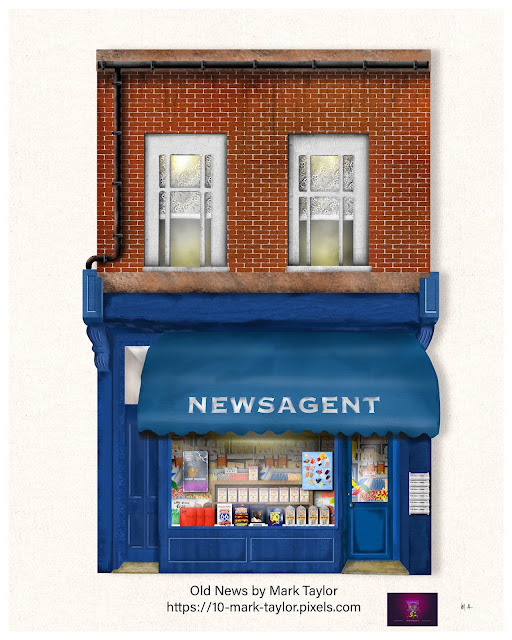 |
| Old News by Mark Taylor |
- Murals and street art have transformed
public spaces and there are plenty of great examples that can be found on
Google’s Arts & Culture. https://artsandculture.google.com/
Public Installations: Sculptural installations, interactive artworks, and temporary
exhibits can spark curiosity, generate conversation, and create unique
destinations within the high street. Think Antony Gormley’s “Another
Place” on Crosby Beach or Yoko Ono’s “Imagine Peace Tower” in
Iceland.
Light Installations: Illuminating buildings, streets, and squares with creative lighting
design can create a magical atmosphere, attract visitors after dark, and
highlight architectural features. For example, the annual Lumiere festival in
Durham transforms the city into a wonderland of light. My nearest Cathedral,
Lichfield in Staffordshire, UK, is completely illuminated over the Christmas
period, attracting thousands of visitors each year. You can see it lit up right
here. https://www.lichfield-cathedral.org/news/news/post/615-the-lichfield-cathedral-light-show-is-back
The complexity of todays high
street often makes projects more difficult to manage. Local controls, planning
and zoning permissions, and multiple stakeholders in properties becomes a
bureaucratic nightmare, but once barriers are removed and communities begin to
engage with local businesses, authorities and landlords, the examples earlier
demonstrate how community projects can have a huge impact in reviving the
social fabric that has been lost in time.
 |
| The Tea Rooms by Mark Taylor |
One of the best news stories
from the UK has been from the Nudge Community which you can find out more about
right here: https://www.nudge.community/whatwedo
The Nudge community believe that
the small things are important, the high street isn’t just about buildings,
it’s about people and making connections. Nudge aim to bring lasting change in
surprising and entertaining ways to build a strong local community and a strong
local economy.
Their mantra is to nudge local
people and businesses to be brave, creative and resilient and healthy,
supporting themselves and their community. Empty buildings in private ownership
have caused long term problems along Union Street for decades.
An important part of changing
the street is making sure some buildings are owned by the community. This means
they can use these buildings to create a street that meets the needs of local
people and more of the economic impact from changes they make stays in the
community.
There are plenty of other
examples of local communities taking a lead on high street recovery efforts,
pop up art galleries and studios that showcase the work of local artists.
Storefront for Art in New York have done this successfully which demonstrates
that even the worlds biggest and boldest cities haven’t seen some decline, but
whenever they have shown signs of decay there have been projects set up to turn
fortunes and communities around.
There are also examples of
community art workshops, with collaborations from local artists engaging
directly with those who might just buy into their work and we have seen great
examples especially since that horrible period we all experienced during 2020
and 2021. Artist-led regeneration projects that empower local artists to lead
the transformation of neglected areas through creative interventions, promoting
both community participation and placemaking. Projects like “Art
Block” in Baltimore and “Creative Time” in New York exemplify
this approach.
Of course it’s one thing
shouting loudly that we all want change, it’s an entirely different story when
it comes to actually getting people to buy into the concept of actually doing
something about it. Sure we can look to governments for answers, but I think
recent and not so recent experience of political interventions have
demonstrated better than anything else that community adhesion is difficult,
mostly, politicians can’t even agree with each other.
There has to be a combination of
intent, willingness, and leadership before you stand any chance of uniting
communities, I’m not convinced that with a few global exceptions, we would
necessarily find those qualities in modern day politics. I think, if we want
communities and high streets to thrive then the very people who are shouting
need to step up, no matter how little
they contribute, as long as they contribute something.
There are plenty of examples
here too.
- Community Murals: Involve
residents in creating murals that reflect their stories, values, and
aspirations, fostering a sense of shared identity and pride in the
community. Projects like “East Belfast Arts Project” and
“The Mosaic Mural Project” in Philadelphia stand as testaments
to this power. - Participatory Art Installations: Create
interactive installations that encourage collaboration and participation,
bringing people together in a shared creative experience. Think Candy
Chang’s “Before I Die” walls or Yoko Ono’s “Wish
Tree.” - Arts Festivals and Events: Organise
regular art festivals, street performances, and creative events within the
high street, attracting visitors, showcasing local talent, and injecting
vibrancy into the space. The Edinburgh Fringe Festival and Notting Hill
Carnival are prime examples.
Sometimes it’s problematic to
quantify how some of these more creative interventions contribute to the local
economy, but when I walked through my local town centre’s craft market last
year the local adjoining shops were definitely busier than on any other day,
car parks were full and there were clearly people attending who had travelled
into the region.
Art tourism attracts visitors,
Liverpool’s Tate Gallery is a semi-regular haunt of mine, it’s little over an
hour away and I always make time to walk through the local community to enjoy
coffee at an independent coffee shop whenever I make the visit.
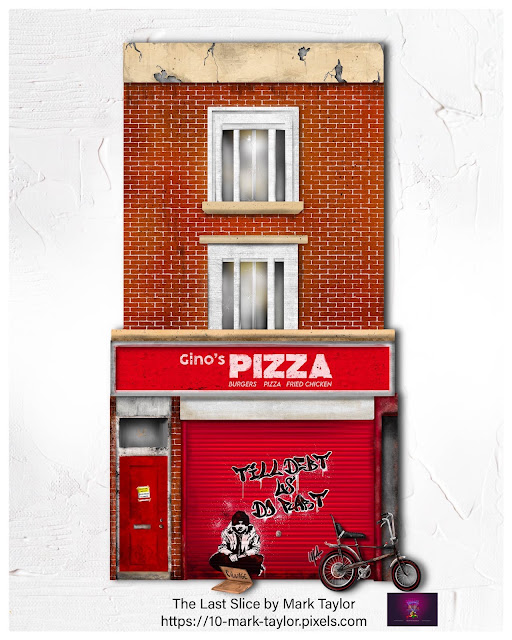 |
| The Last Slice by Mark Taylor |
If communities want artists to
engage, the best way in my own experience is to make affordable studio space
available, host markets that promote the local arts scene rather than importing
art from other regions, and it’s vital that businesses collaborate with artists
and both parties remember that collaborations are two way relationships.
One area where I have seen
plenty of innovation around collaboration is where local retailers have
incorporated local artists work into window and internal displays. They’ve also
continued the theme by using a collaboration of the same local artists to create
the graphic design and branding elements and the best examples of this have
elevated the consumer experience and provided a very unique look and feel to
the business.
The barriers to becoming a
professional artist and making a living wage from your creativity are many and
varied. It’s entirely possible to create art out of anything and someone
somewhere will find value in that work, but if you want to express your
creativity using equipment that you might not as yet be able to afford,
becoming an artist is very much a chicken and egg paradox.
This is where community led
maker spaces have become critical to the success of local creative sectors.
Their unique combination of resources, community, and innovation can be
powerful tools for infusing new life into stagnant local economies.
By providing affordable
workspaces and access to equipment, Maker Spaces offer access to tools,
machinery, increasingly 3D printer farms, and other technologies that aspiring
creatives and entrepreneurs might not otherwise be able to afford.
Maker spaces are excellent at
encouraging a culture of innovation and collaboration. The community led
environment brings together creatives of all disciplines and skills and they do
tend to become hubs of shared expertise with plenty of mentors and peers
willing to share their skills. One example I looked at last year also had
members of the local business community sharing their business development
knowledge with each other and those businesses would then collaborate with
local makers to create bespoke local arts and crafts which were then sold
exclusively in the community.
Maker Spaces also tend to be
hotbeds of prototyping and product development, if something can be designed to
fill a local need quickly, it’s far quicker to cut out the logistical headaches
and supply chain issues by keeping everything confined to the local area
wherever it’s possible and that links perfectly to the green agenda which can
in itself often lead to grants opportunities.
The most successful Maker spaces
can also develop tomorrows local workforce. Offering workshops and training
programs, Maker spaces can provide training in various technical
skills, including digital
fabrication, welding, woodworking, and
electronics, creating a more skilled workforce and attracting new
industries.
They can promote local
manufacturing and production by facilitating small-scale production and
encouraging the use of local materials, contributing to a more resilient
and self-sufficient and critically, a more sustainable local economy.
They’re also great for emerging
technologies and industries. Maker spaces can act as incubators for new
technologies, such as 3D printing and robotics, attracting investment
and fostering the growth of future-oriented industries.
 |
| A Stick of Blackpool Rock by Mark Taylor |
- Creating new retail opportunities: Maker
spaces can host markets and events showcasing locally made
products, attracting customers and generating income for makers and
artisans. - Encouraging collaboration between makers
and local businesses: Partnerships between makers and
established businesses can lead to innovative products, unique retail
experiences, and increased foot traffic in local shops. - Boosting tourism and economic
diversification: Maker spaces can become tourist
destinations, attracting visitors interested in unique
products, workshops, and demonstrations, diversifying the
local economy beyond traditional industries.
Personally, I can’t think of a
downside to a Maker space so long as you can ensure bold leadership, a
willingness and intent to engage with the wider community, and an ambition to
work with the entire community. If you are setting a maker space up, you also
need someone to sell the vision to the local community and perhaps just as
importantly, to local businesses and education providers. They are
all-encompassing, the best will have partnerships and a thousand moving parts
in the background and they will have landed the right messages with the
community, they will have also done the outreach work and fostered champions to
spread the word.
Maker spaces foster a sense of
community by offering a space for people to connect, learn, and
create together, encouraging collaboration and social interaction. That
means that you will want to engage with local government and you will need to
onboard local education providers because there is a real opportunity here to
promote further education and STEAM learning, vitally important for tomorrows
economy.
Engaging young people in the
maker experience can spark an interest in science, technology, engineering and
arts, the exact roles that build the foundations of any economy. Young people
need to be encouraged so that they can be better prepared for the needs of
future employment markets, particularly where people already in skilled roles
and heading rapidly towards retirement haven’t been able to pass on knowledge
and skills because of skills shortfalls. I call it community succession
planning, something that I think even globally, we haven’t always been great at
doing.
If you land this correctly, a
vibrant maker ecosystem can attract skilled individuals and
entrepreneurs, contributing to a more dynamic and diverse local
population. There are some caveats, mainly around how effective the leadership
is, ideally that should be someone with a modicum of business nous and
experience in the creative sector.
The rest is purely down to
ensuring that folks are committed to making the project work, and local
business stepping up and engaging. All of this might sound like an impossible
ask in some communities but where Maker Spaces have worked well it has usually
been in areas that have been forgotten about for years.
Further Resources:
Fixing the high street is
complex and it needs a coalition of the willing to make the changes needed and
drive local projects forward. Can we rely on cash-strapped governments and
local authorities to resolve any of this, I’m not sure we can despite how confident
I think we can all be that a thriving community heartbeat contributes
positively to local and national economies. To some extent it should be front
and centre of central/federal/state/local, government policy but apparently,
that’s not where we’re at in many places.
But as creatives, if there are
ways that we can collectively find to encourage more people to participate in
the sector then I think, in the name of art we should probably do something to
at least start the conversation.
Of course there will be
pockets of the population who have become disengaged with the concept of
community, that’s why strong leadership and a solid sales pitch are essential.
The walls of apathy need to be broken down and I suspect, this is going to be a
long slow process until someone shouts hey, this high street and community
thing might just be a great idea!
There is a question as to why
this should fall to creatives, I think the answer might just be that these kind
of problems often need a creative answer and besides, widening participation
and appreciation of the arts can’t really be a bad thing can it?
Where to buy Mark’s work…
You can purchase Mark’s work
through Fine Art America or his Pixels site here: https://10-mark-taylor.pixels.com You
can also purchase prints and originals directly. You can view Mark’s portfolio
website and see a small selection of his works
at https://beechhousemedia.com
All artwork and blog posts are
copyright Mark Taylor and must not be reused without written permission and
appropriate licencing.

